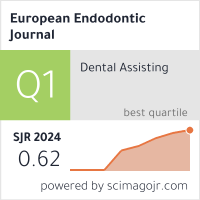Metrics
2024 IMPACT FACTOR
5 year Impact Factor
Eigenfactor Score
2024 CiteScore
Journal Citation Reports
(Clarivate 2025, JIF Rank)
Nickel-Titanium Rotary File Systems: Whats New?
Sadia Tabassum1, Kamil Zafar2, Fahad Umer21Department of Operative Dentistry, Jinnah Medical and Dental College, Karachi, Pakistan2Department of Surgery (Section of Operative Dentistry), Aga Khan University Hospital, Karachi, Pakistan
Ever since their introduction, nickeltitanium (NiTi) alloys have continued to revolutionize the field of endodontics. They have considerable advantages over the conventional stainless steel file in terms of mechanical properties. However, despite of their superior mechanical properties, NiTi alloys still pose some risk of fracture. Consequently, there has been considerable research conducted to investigate the mechanisms behind the occurrence of these procedural errors. Since the last decade, different proprietary processing procedures have been introduced to further improve the mechanical properties of NiTi alloys. These treatments include thermal, mechanical, electropolishing, and recently introduced electric discharge machining. The main purpose of these treatments is to impart a more martensitic phase into the files at normal body temperature, so that the maximum advantage of flexibility can be obtained. These heat-treated instruments also possess improved cyclic fatigue resistance when compared to conventional NiTi alloys. NiTi alloys can be subclassified as the instruments mainly containing austenitic phase (conventional NiTi, M-wire, R-phase), and those containing martensitic phase (controlled memory wire, ProTaper Gold, and Vortex Blue). Instruments based on austenitic alloys possess superelastic properties due to the stress-induced martensitic transformation. Contrary to this, martensitic alloys can easily be deformed due to phase transformation, and they can demonstrate the shape memory effect when heated. This review discusses the different phase transformations and heat treatments that the NiTi instruments undergo.
Keywords: Austenite phase, controlled memory, martensite phase, nickeltitanium (NiTi) alloys, instrumentation and rotary, R-phase, thermo-mechanical treatment
Manuscript Language: English
(1918 downloaded)



